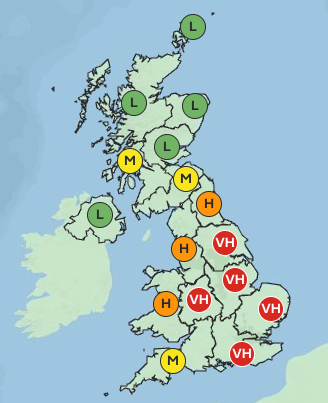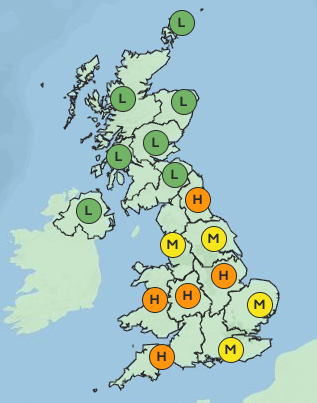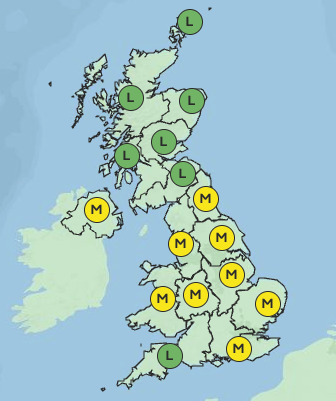Britons with hay fever should brace for itchy eyes and runny noses this Easter Bank holiday weekend as pollen counts are set to remain high.
The West Midlands, East Midlands, Yorkshire and Humber, London and the South East will experience “very high” pollen levels on Friday, the Met Office said.
Wales, North East and North West England are also all set to have high pollen levels on Friday.
Over the weekend pollen levels will start to dip, with levels dropping from “very high” to “high” in West Midlands, East Midlands, Yorkshire and Humber, London and the South East before slowly dropping to “medium” over Sunday and Monday.
Pollen levels remain low in Scotland for most of the weekend.


The Met Office said the UK is experiencing higher than average levels of birch pollen this year due to the ideal conditions for pollen production last spring and summer.
Recent weather conditions have also been ideal for tree pollen being released, the forecaster said, and low rainfall has meant pollen hasn’t been washed out of the atmosphere.
High pollen counts could mean many people could experience sneezing, itchy eyes, mouth and throat and blocked noses.
More than 10 million people in Britain suffer from hay fever, according to the Met Office.
The pollen count is the number of particles per cubic metre of air, with a reading of between 50 and 150 grains of grass pollen considered high.


A Met Office spokesperson said: “We are currently in tree pollen season, with the main allergenic species being birch pollen. The release of birch pollen has started at a similar time to previous years.
“However, we are experiencing higher than average levels of birch pollen this year due to the ideal conditions for pollen production last spring and summer.
“The weather so far this spring has been ideal for tree pollen being released and in addition, the low rainfall has meant pollen hasn’t been washed out of the atmosphere.
“Tree pollen impacts about 25 per cent of hay fever suffers and so is a significant cause of hay fever at this time of year.”
The Met Office said the symptoms of hay fever include “frequent sneezing, a runny or blocked nose, itchy eyes and an itchy throat, mouth, nose and ears.”
“As a sufferer, you may also experience the loss of your sense of smell, facial pain, sweating and headaches – although these symptoms are less common,” it added.
“Asthma sufferers may find that their symptoms get worse when suffering from hay fever and may experience a tight chest, shortness of breath, coughing and wheezing.”
There is no cure for hay fever, although most people can relieve their symptoms with treatment.
The Met Office’s advice said: “The most effective way to prevent hay fever is to avoid exposure to pollen but this is almost impossible, particularly during the summer months.
“Instead, many people rely on antihistamines, which can prevent the allergic reaction from happening, and corticosteroids, which reduce any inflammation and swelling caused by the pollen allergy. Eye drops can also help.
“Over-the-counter treatments should be sufficient to ease your hay fever symptoms, but if you are experiencing more severe symptoms, you should speak to your GP.”
Suspended chief constable will not be prosecuted over alleged sexual offences
UK holiday hotspot hit by heavy rain weather warning for Easter weekend
MI5 files not deliberately withheld from Stakeknife probe, review concludes
Oak felled by Toby Carvery owners had ‘few hundred years’ more to live
Easter supermarket opening times 2025 for Tesco, Asda, Aldi, and more
Easter travel disruption warning with hundreds of closures planned - traffic live







